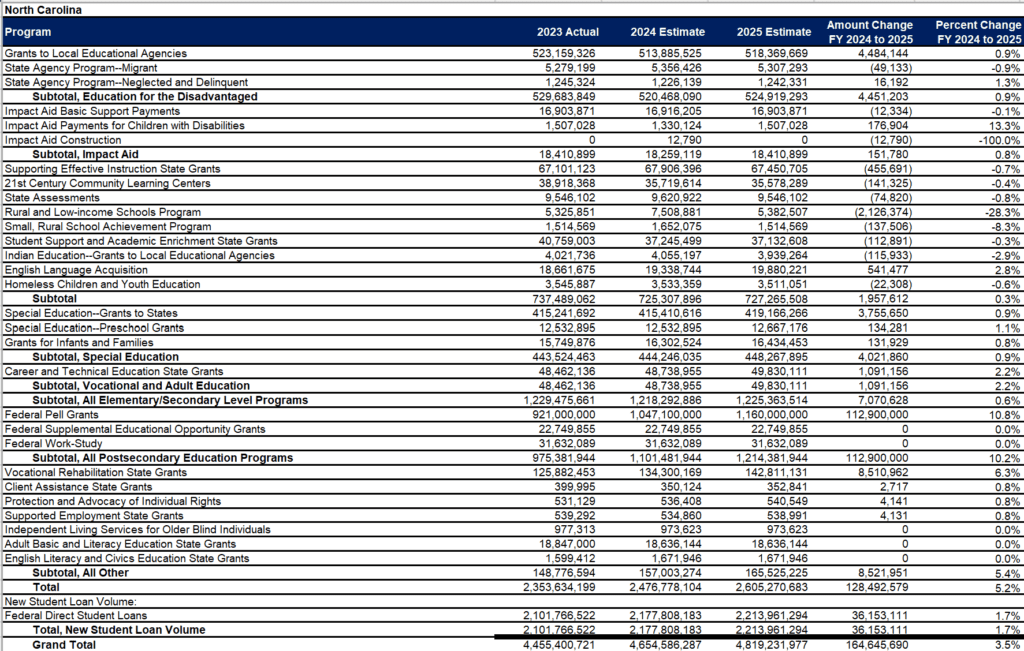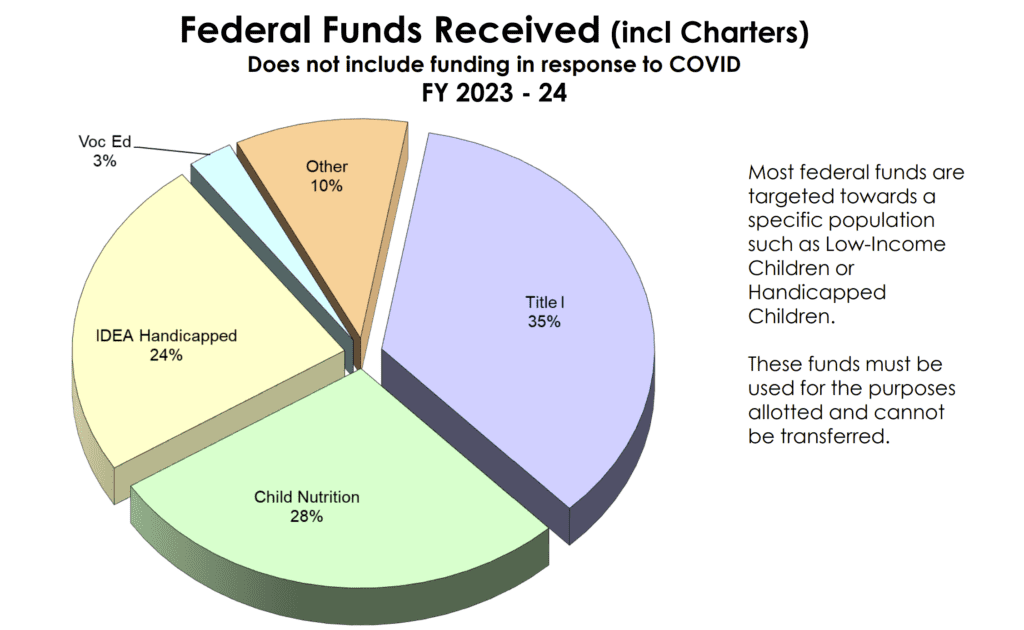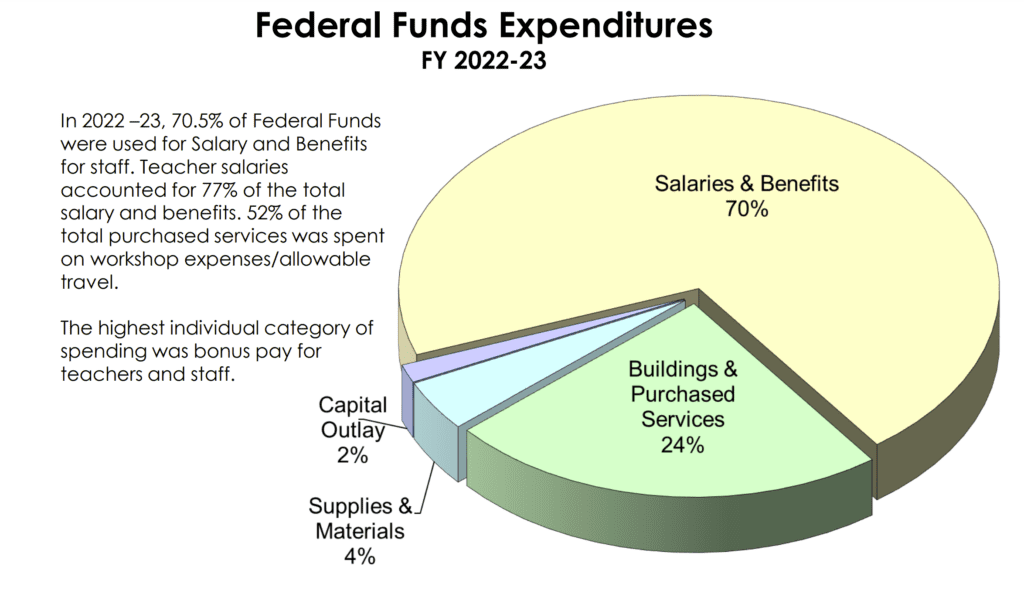
|
|
Recently, WRAL published an article providing more information on what Mark Robinson, the Republican candidate for governor, and Michele Morrow, the Republican candidate for superintendent of public instruction, are saying about federal funding for education, and that is leading many to wonder whether Robinson or Morrow might urge lawmakers to decline federal funding if elected.
Specifically, the article reports Robinson said:
“If I had my way about it,” Robinson responded, “they’d send the check and I’d say, ‘Oh, no, you can have it. I don’t want your money. Your money comes with too many rotten obligations. We don’t want it.’”
“Honestly, come on. There should be no federal department of education,” Robinson said.
And the article reports Morrow said:
“People need to recognize that the federal government, along with every dollar that they give us, there is an expectation that we are going to push an agenda that comes from them, and that comes with strings,” Morrow said.
Morrow said if she’s elected, her first step will be to “audit” federally funded programs at the Department of Public Instruction to see if they contribute to student achievement. If not, she said she’ll tell federal officials, “Back off. We don’t need your money, and we’re going to do it just as a state.”
How much money is at stake?
A lot.
The N.C. Department of Public Instruction’s annual budget highlights report shows that the state receives $1.10 billion in federal funding, not including child nutrition or COVID relief.
That figure doesn’t provide the full picture.
EdNC asked the U.S. Department of Education for more information about its funding for education in North Carolina. The following does not include funds awarded to DPI and other entities on a competitive basis.

In 2025, the U.S. Department of Education estimates North Carolina would receive $1.2 billion for elementary and secondary education.
According to the federal department, here is the funding by state, and here is the funding by program, in case you want to dive deeper into the numbers. Here is where you can find more information on the federal department’s website.
There is another $713 million in funding from the U.S. Department of Agriculture for child nutrition.
Federal funding can be particularly important where states have unforeseen expenses, for instance during a global pandemic. According to DPI’s budget highlights, it received $6.3 billion in COVID relief. You can see all of the things this money funded on pp. 45-48.
You can see all of the federal grants administered by DPI on pp. 39-44.
As indicated by the U.S. Department of Education, federal funding also is awarded to other entities in North Carolina — for example, Duke University’s $49.8 million grant for community schools, Village of Wisdom’s $5 million grant for education innovation and research, TIP’s $21 million grant for the Teacher and School Leader Incentive Program (TSL) Grant, and Appalachian State University’s $35 million GEAR UP grant to work with 12 school districts, among many, many others.
What do federal funds pay for?
DPI’s budget highlights includes two charts that show what the federal funds are received for and spent on.


Are calls to eliminate the Department of Education or decline federal funding new?
Calls to eliminate the U.S. Department of Education or decline federal funding are not new.
“Just as they are today, early efforts to shutter the department were animated by claims about bloated bureaucracy, excessive spending, and federal overreach into states’ education systems,” Education Week recently reported in this article, “Why It’s So Hard to Kill the Education Department—and Why Some Keep Trying.”
It surprises many to realize that there is no federal constitutional right to an education in the United States. For more than 50 years, federal funding has been a way for the federal government to make sure states had enough resources to increase educational outcomes for higher-cost students.
Project 2025 and the 2024 GOP platform call for eliminating the U.S. Department of Education, and Project 2025 also calls for converting federal funding to block grants without strings or eliminating the funding altogether.
Project 2025, also called the 2025 Presidential Transition Project, was spearheaded by the conservative Heritage Foundation but includes a broad coalition of conservative organizations. Its policy manual, “Mandate for Leadership: The Conservative Promise,” is 30 chapters and 922 pages long. Donald Trump, the Republican candidate for president, is distancing his campaign from the project. Here is his education agenda.
Oklahoma, Tennessee, and Utah have all considered declining federal funding.
What happened in Tennessee?
In fall 2023, the Tennessee legislature created the Joint Working Group on Federal Education Funding to explore the idea of declining federal funding, which no state has done to date.
An organization called the Sycamore Institute — an independent, nonpartisan public policy research center in Tennessee — published two reports on federal funding in the state and testified before the working group:
- Federal Funding for Tennessee’s School Districts in August 2023, including an interactive dashboard, and
- Federal Funding for K-12 Education in Tennessee in October 2023.
The Institute found that the “school districts most reliant on federal dollars tend to be more rural, have more low-income and disabled students, less capacity for local revenue, and lower ELA test scores.”
The Senate-side of the Joint Working Group issued this bipartisan report in January 2024, including these findings:
There are more questions than definitive answers about what rejecting federal K-12 dollars could mean for Tennessee’s obligations because no state has ever done so.
Many federal requirements could still apply to Tennessee schools even if the state rejected federal K- 12 dollars, creating questions that would likely be resolved in court.
It is also important to consider that many of the requirements attached to federal dollars align with state policymakers’ goals and/or are integrated into the state’s own requirements. Therefore, many federal grants provide the state with monetary support for policies that the state would likely implement on its own.
Most federal dollars for educational programs are distributed to states based on a formula. If Tennessee rejected some or all of the money it receives from these programs, those funds would not result in federal taxpayer savings unless Congress reduced its funding amounts by the same amount. While possible, it seems more likely that those funds would instead be redistributed to other states.
Impact by district in North Carolina
With a $1.7 billion estimate of federal revenue for education, the North Carolina Justice Center released last week this analysis of the district-level impact of the rejection of federal funding, including how the cuts would translate to lost resources, like teachers, teacher assistants, psychologists, counselors, social workers, and nurses.
“Cuts wouldn’t fall equally across districts,” writes Kris Nordstrom, senior policy analyst with the N.C. Justice Center’s Education & Law Project. “Districts serving students with the greatest needs would experience bigger budget cuts than districts that have more resources and fewer students from low income families.”





